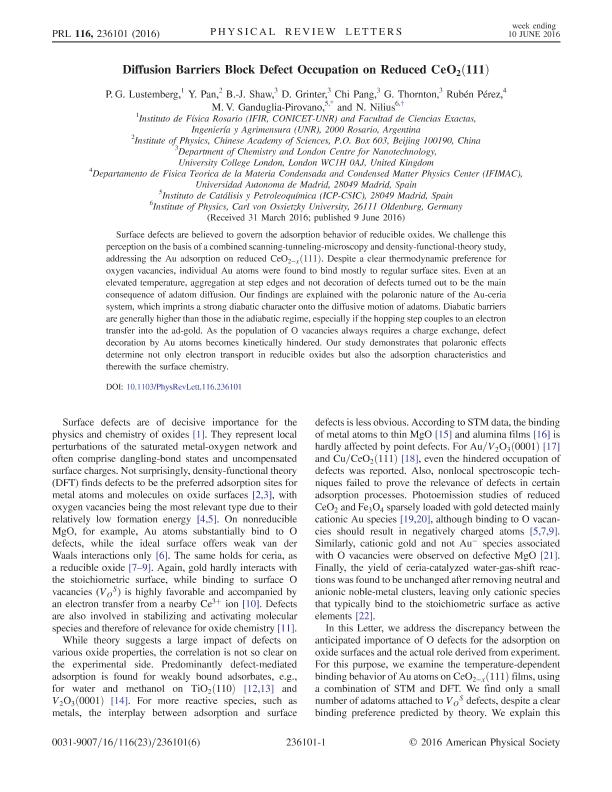Mostrar el registro sencillo del ítem
dc.contributor.author
Lustemberg, Pablo German

dc.contributor.author
Pan, Y.
dc.contributor.author
Shaw, B. J.
dc.contributor.author
Grinter, D.
dc.contributor.author
Pang, Chi
dc.contributor.author
Thornton, G.
dc.contributor.author
Pérez, Rubén
dc.contributor.author
Ganduglia Pirovano, Maria Veronica

dc.contributor.author
Nilius, N.
dc.date.available
2018-07-19T18:28:07Z
dc.date.issued
2016-06
dc.identifier.citation
Lustemberg, Pablo German; Pan, Y.; Shaw, B. J.; Grinter, D.; Pang, Chi; et al.; Diffusion Barriers Block Defect Occupation on Reduced CeO2 (111); American Physical Society; Physical Review Letters; 116; 23; 6-2016
dc.identifier.issn
0031-9007
dc.identifier.uri
http://hdl.handle.net/11336/52675
dc.description.abstract
Surface defects are believed to govern the adsorption behavior of reducible oxides. We challenge this perception on the basis of a combined scanning-tunneling-microscopy and density-functional-theory study, addressing the Au adsorption on reduced CeO2-x(111). Despite a clear thermodynamic preference for oxygen vacancies, individual Au atoms were found to bind mostly to regular surface sites. Even at an elevated temperature, aggregation at step edges and not decoration of defects turned out to be the main consequence of adatom diffusion. Our findings are explained with the polaronic nature of the Au-ceria system, which imprints a strong diabatic character onto the diffusive motion of adatoms. Diabatic barriers are generally higher than those in the adiabatic regime, especially if the hopping step couples to an electron transfer into the ad-gold. As the population of O vacancies always requires a charge exchange, defect decoration by Au atoms becomes kinetically hindered. Our study demonstrates that polaronic effects determine not only electron transport in reducible oxides but also the adsorption characteristics and therewith the surface chemistry.
dc.format
application/pdf
dc.language.iso
eng
dc.publisher
American Physical Society

dc.rights
info:eu-repo/semantics/openAccess
dc.rights.uri
https://creativecommons.org/licenses/by-nc-sa/2.5/ar/
dc.subject
Ceria
dc.subject
Surface Oxygen Defects
dc.subject
Au Adsorption
dc.subject
Dft
dc.subject
Stm
dc.subject.classification
Otras Ciencias Químicas

dc.subject.classification
Ciencias Químicas

dc.subject.classification
CIENCIAS NATURALES Y EXACTAS

dc.title
Diffusion Barriers Block Defect Occupation on Reduced CeO2 (111)
dc.type
info:eu-repo/semantics/article
dc.type
info:ar-repo/semantics/artículo
dc.type
info:eu-repo/semantics/publishedVersion
dc.date.updated
2018-07-18T20:41:04Z
dc.journal.volume
116
dc.journal.number
23
dc.journal.pais
Estados Unidos

dc.journal.ciudad
Nueva York
dc.description.fil
Fil: Lustemberg, Pablo German. Consejo Nacional de Investigaciones Científicas y Técnicas. Centro Científico Tecnológico Conicet - Rosario. Instituto de Física de Rosario. Universidad Nacional de Rosario. Instituto de Física de Rosario; Argentina
dc.description.fil
Fil: Pan, Y.. Chinese Academy of Sciences; República de China
dc.description.fil
Fil: Shaw, B. J.. University College London; Estados Unidos
dc.description.fil
Fil: Grinter, D.. University College London; Estados Unidos
dc.description.fil
Fil: Pang, Chi. University College London; Estados Unidos
dc.description.fil
Fil: Thornton, G.. University College London; Estados Unidos
dc.description.fil
Fil: Pérez, Rubén. Universidad Autónoma de Madrid; España
dc.description.fil
Fil: Ganduglia Pirovano, Maria Veronica. Consejo Superior de Investigaciones Científicas; España
dc.description.fil
Fil: Nilius, N.. Carl von Ossietzky University; Alemania
dc.journal.title
Physical Review Letters

dc.relation.alternativeid
info:eu-repo/semantics/altIdentifier/doi/https://dx.doi.org/10.1103/PhysRevLett.116.236101
dc.relation.alternativeid
info:eu-repo/semantics/altIdentifier/url/https://journals.aps.org/prl/abstract/10.1103/PhysRevLett.116.236101
Archivos asociados
